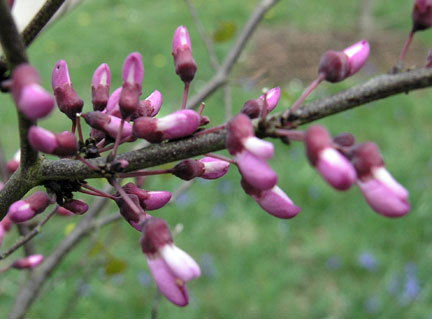| General Description | C. occidentalis is a deciduous plant that provides a magnificent show in the spring when with its pinkish-purple flowers blooming before leaf emergence. The leaves are ovate at the base and orbicular at the apex and in the autumn the green blue foliage turns yellow to red. It grows to a height of 4-6 meters and has a broad-spreading crown that ascends close to the ground. It is tolerant of most soil types but flourishes in those that are well drained in partial to full sun. Of note is the need for a winter chill (not below 0� C) to set flowers properly. Once established the Western Redbud requires little water and is moderately drought tolerant. |
| ID Characteristic | C. occidentalis has beautiful pink to purple pea-shaped flowers that emerge in spring prior to leaf emergence. In the autumn the leaves turn yellow and red while the seed pods remain on tree during the winter creating year-round interest. |
| Shape | Vase shaped, often multi-stemmed. |
| Landscape | Western Redbud can be used for mass planting or as a specimen tree. It is suitable for parking lot island plantings, medians, or beside sidewalks as a residential tree, in lawns, parks or home gardens. |
| Propagation | Using ripe seed soak in boiling water and let sit for several days, to the point that the seed become quite plump and almost twice the size. Plant in flats or pots and provide a cold treatment (5°C) for three months at which point germination should occur. |
| Cultivation | Western Redbud prefers full to partial sun in clay, loam, sand, acidic or alkaline soils that are well-drained. Plants require minimal watering once established as it is moderately drought to tolerant: it grows well on slopes. |
| Pests | The long term health of the Western Redbud is not usually affected by pests but it may be subject to common pests such as weevils, caterpillars, whiteflies and scale insects. May be browsed by deer or farm animals. Known to be resistant to oakwood root fungus but is susceptible to verticillium wilt. |
| Notable Specimens | Indigenous plants may be seen in Sonoma County (wine country) in northern California, including Chapparral, Douglas Fir Forest, Joshua Tree Woodland, Yellow Pine Forest and Central Oak Woodland. Individual specimens can be seen at the University of California, Davis Campus Arboretum, San Francisco, California, United States of America. |
| Habitat | Canyons, woods and sunny slopes. Western Redbud prefers full to partial sun in clay, loam, sand, acidic or alkaline soils that are well-drained. Plants require minimal watering once established as it is moderately drought tolerant: it grows well on slopes. |
| Bark/Stem Description | Smooth, grey bark, thin and can be easily damaged by impact from any mechanical devices, may be mulitrunked with thorns. |
| Leaf Description | Blue-green colour in spring turning to yellow in autumn, 1- 2 cm blade length, leaf shape is cordate, ovate with alternate arrangement, slightly waxy on edges and glossy. |
| Flower Description | Showy flowers, small clusters along the branches, spring flowering, each flower has five petals that range in colour from magenta pink to purple with the entire plant being in bloom for about two weeks. |
| Fruit Description | Elongated, bean shaped, pointed at tip, dry, hard pod, each pod contains 6- 7 hard bean-like seeds, fruit attracts birds and does not present a significant litter problem. The seed pods are reddish purple when immature, turning grey brown towards maturity and persisting on the tree through the winter. |
| Colour Description | Flowers are pink turning a more intense colour as they mature.The leaves are light green progressing to a soft yellow in autumn while the bark is light grey. |
| Texture Description | Medium texture in growing and dormant seasons. |
